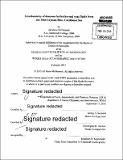| dc.contributor.advisor | Jeffrey S. Seewald and Christopher R. German. | en_US |
| dc.contributor.author | McDermott, Jill Marie | en_US |
| dc.contributor.other | Woods Hole Oceanographic Institution. | en_US |
| dc.coverage.spatial | cc----- | en_US |
| dc.date.accessioned | 2015-06-10T19:11:06Z | |
| dc.date.available | 2015-06-10T19:11:06Z | |
| dc.date.copyright | 2015 | en_US |
| dc.date.issued | 2015 | en_US |
| dc.identifier.uri | http://hdl.handle.net/1721.1/97337 | |
| dc.description | Thesis: Ph. D., Joint Program in Chemical Oceanography (Massachusetts Institute of Technology, Department of Earth, Atmospheric, and Planetary Sciences; and the Woods Hole Oceanographic Institution), 2015. | en_US |
| dc.description | Cataloged from PDF version of thesis. | en_US |
| dc.description | Includes bibliographical references. | en_US |
| dc.description.abstract | This thesis examines the controls on organic, inorganic, and volatile species distributions in hydrothermal fluids venting at Von Damm and Piccard, two recently discovered vent fields at the ultra slow spreading Mid-Cayman Rise, Earth's deepest mid-ocean ridge. A wide variety of possible temperatures and substrates for fluid/rock reaction exist at ultraslow spreading ridges. The flux of chemicals delivered to the ocean by circulating vent fluids exerts a major control on mass transfer into and out of the oceanic crust and supports chemosynthetic ecosystems. In Chapter 2, abiotic organic synthesis is shown to occur via two distinct mechanisms in the serpentinizing Von Damm system. Longstanding questions concerning the spatial, temporal, and mechanistic nature of carbon transformations in deep-sea hot springs are addressed. In contrast with the current paradigm, CH4 is not actively forming during circulation of H2-rich vent fluids, but instead is derived from fluid inclusions in the host rocks. Chapters 3 and 4 present in-depth studies of the chemical and isotopic compositions of aqueous species in vent fluids at Von Damm and Piccard to elucidate the role of reaction temperature, pressure, substrate composition, and water/rock mass ratios during the chemical evolution of hydrothermal fluids at oceanic spreading centers. At Von Damm, sequential reaction of gabbroic and peridotite substrates at intermediate temperatures can explain generation of the observed fluids. Geochemical modeling shows that talc-quartz assemblage is expected to precipitate during fluid mixing with seawater at the seafloor. At Piccard, extremely high temperature subsurface water/rock reaction results in high temperature fluids that are richer in dissolved H2 than any previously observed fluids worldwide. At both locations, high-H2 conditions promote the abiotic reduction of [Epsilon]CO2 to formate species, which may fuel a subsurface biosphere. In Chapter 5, multiple sulfur isotopes were measured on metal sulfide deposits, So, and fluid H2S to constrain sulfur sources and the isotopic systematics of precipitation in a wide variety of seafloor hydrothermal vents. Areas studied include the eastern Manus Basin and Lau Basin back-arc spreading centers, the unsedimented basalt-hosted Southern East Pacific Rise, and the sediment-hosted Guaymas Basin mid-ocean ridge spreading centers. Limited isotope fractionation between fluid H2S and precipitating chalcopyrite implies that sulfur isotopes in a chimney lining may record past hydrothermal activity. | en_US |
| dc.description.statementofresponsibility | by Jill Marie McDermott. | en_US |
| dc.format.extent | 249 pages | en_US |
| dc.language.iso | eng | en_US |
| dc.publisher | Massachusetts Institute of Technology | en_US |
| dc.rights | M.I.T. theses are protected by copyright. They may be viewed from this source for any purpose, but reproduction or distribution in any format is prohibited without written permission. See provided URL for inquiries about permission. | en_US |
| dc.rights.uri | http://dspace.mit.edu/handle/1721.1/7582 | en_US |
| dc.subject | Joint Program in Chemical Oceanography. | en_US |
| dc.subject | Earth, Atmospheric, and Planetary Sciences. | en_US |
| dc.subject | Woods Hole Oceanographic Institution. | en_US |
| dc.subject.lcsh | Biogeochemical cycles | en_US |
| dc.subject.lcsh | Chemical oceanography | en_US |
| dc.title | Geochemistry of deep-sea hydrothermal vent fluids from the Mid-Cayman Rise, Caribbean Sea | en_US |
| dc.type | Thesis | en_US |
| dc.description.degree | Ph. D. | en_US |
| dc.contributor.department | Joint Program in Chemical Oceanography | en_US |
| dc.contributor.department | Woods Hole Oceanographic Institution | en_US |
| dc.contributor.department | Massachusetts Institute of Technology. Department of Earth, Atmospheric, and Planetary Sciences | |
| dc.identifier.oclc | 910514507 | en_US |
